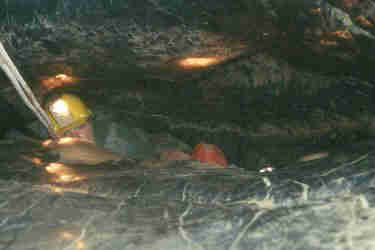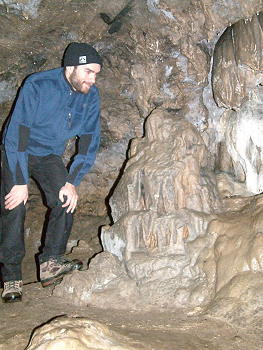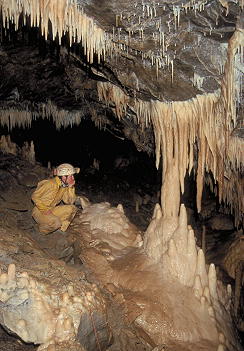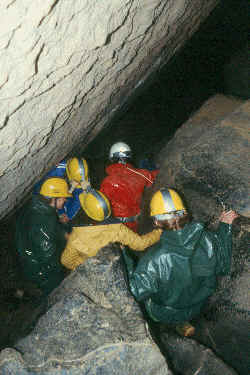Back to "Cave Protection
Home"
GUIDED TOURS
Guiding a number of non-cavers around in a cave is called a
"guided tour". There has been, in our country, a lot of
discussion about this issue and the problems that are related to it.
Without exaggeration, we can say that it is one of the most difficult
issues around. These days, everyone seems to feel the need to crawl
around in a cave: school classes, survival-groups, even managers and
executives want to test their "stress-resistance" by going
caving a day. One can discuss for hours or days about the fact if we
cavers should or may organize or accompany such tours.
But about one thing the majority of cavers seems to agree: the fact that the phenomenon of the "guided tours" -
wether it is being done by "real" cavers or by commercial
outdoor centres - is responsible for the fast and irreversible
deterioration of our caves over the past few decades. Indeed, every
caver knows (or should know; and if not: please visit our other pages
about cave protection!) that caves are fragile environments, especially
the geological and mineralogical aspects of them. An environment that
recovers extremely slow from the damage it undergoes... so slowly
(thousands of years) that we can consider, from a human life point of
view, the damage as being permanent...
This environment cannot handle many visitors... and this is exactly
where the main problem of the "Guided tours" phenomenon lies.
FIGURES?
Obviously, we do not have precise figures. But we can
(as far as Belgium is concerned) try to make an estimation. We do know,
for the Flemish Caving Federation (VVS), how many
"one-day-insurances for guests" are taken per year. We also
have been able to collect data, by means of hidden cave counters
(electronic devices) in the entrance of popular caves. Now and then,
cave entrances are being systematically controlled: groups are checked,
vehicles and visitors are counted.
We do not have any figures about the number of visitors that Commercial
Outdoor centres guide around in their "own"caves. But we know
approximately the number of Outdoor Centres. Another unknown thing is
the number of people that goes in caves "in the wild", without being accompanied by
real cavers or outdoor centres.
Anyway, we can safely estimate that per year at least 10.000,
but more realistically 20.000 people are guided around in caves.
Maybe even more!
This is a huge number, if one knows that in our country there are not
many caves that are being used (or are suited for) such "tourist
trips"... maybe 20 caves or so.
Since this over-visitation of those caves is going on for at least 40
years now, this means that this handful of caves has been visited by as
many as 400.000 to 800.000 people!
IMPACT?
 It
needs little explanation what the impact of hundreds of thousands of
visitors in the fragile cave environment is. These caves have been
totally devastated. Every formation that was not too big to carry
has been broken or stolen. Every possible part of the cave, not only
formations but also the walls has been muddied by contact with muddy
hands and boots. The cave floor, often clay sediments, has been trampled
everywhere and sometimes knee-deep tracks have been worn out in those
floors! The cave rock itself has been polished and worn, making
everything shiny and slippery; because limestone rock is quite soft and
people crawling over them, will abrade and polish it.
It
needs little explanation what the impact of hundreds of thousands of
visitors in the fragile cave environment is. These caves have been
totally devastated. Every formation that was not too big to carry
has been broken or stolen. Every possible part of the cave, not only
formations but also the walls has been muddied by contact with muddy
hands and boots. The cave floor, often clay sediments, has been trampled
everywhere and sometimes knee-deep tracks have been worn out in those
floors! The cave rock itself has been polished and worn, making
everything shiny and slippery; because limestone rock is quite soft and
people crawling over them, will abrade and polish it.
(picture: Polished rock in a passage
that has been done by at least 100.000 visitors... Trou d'Haquin).
Are all of those people sheer vandals then? No, but the
occasional visitor of a cave, being confronted for the first time in his
life with a dark, wet and slippery, cold, claustrofobic and such hostile
environment as a cave, has others things to worry about than the
wellfare of nice formations, sediments or animals. He/she only thinks of
one thing: myself... how do I get out without having fallen, or
slipped, gotten stuck or made myself ridiculous in front of my
friends.
Even if all of these people would have had a proper training first in
the so-called "Minimal Impact Caving" (a way of caving that
causes minimal damage); the effects would not have been much different.
Too much, is too much...
HOW DO WE HANDLE THIS?
 Repairing
the damage is, sadly enough, hardly possible. We must learn to live with
the fact that dozens of our once beautiful caves have becomes sterile
deserts of mud and worn rock.
Repairing
the damage is, sadly enough, hardly possible. We must learn to live with
the fact that dozens of our once beautiful caves have becomes sterile
deserts of mud and worn rock.
(picture: a totally "worn"
calcite formation... only the rough shape still looks like the original.
Picture taken in the over-visited Trou de la Louve)
It is, in the first place, vital that we avoid that other, still well-conserved
caves would undergo the same faith.
In the second place, we must try to limit and stabilize the damage
in the caves that are already devastated and give them the chance to
begin their long recovery process. This is only possible by reducing the
number of visitors.
WHAT HAS BEEN DONE SO FAR?
- Both the Walloon federation (Union Belge de
Spéléologie, +/- 1300 cavers) and the Flemish Federation (Verbond van
Vlaamse Speleologen, +/- 700 cavers) have introduced about ten years
ago, an "ethical code" that must be respected by all of
its members. A big chapter in this code concerns the "Guided
Tours": how big groups can be, in which caves such tours can be
held, how many cavers should accompany the visitors etc...
The Flemish federation made this code even more severe and introduced
additional limits: each club cannot guide more people per year than
their "quota" (based on the numbers of members of the club);
and also there is an obligation to report every guided tour and the
number of people in the party to the Federation.
- The Walloon federation UBS has also gated systematically the
most popular caves with gates that all can be opened with the same,
common key. Only real caving clubs can obtain a copy of the key.
- The Walloon federation UBS has introduced a competence
certificate (B.I.R.S) and ditto training, that must be in possession
of every "commercial" caver wanting to guide vistors around in
caves controlled by the UBS.
- The Walloon federation UBS has formed a commission that
handles all problems regarding Cave Protection and Access. In this
commission there are representatives of both the Walloon (UBS) and
Flemish (VVS) federations. Over the years, this commission has done a
good and remarkable job.
(NB: unfortunately, and this is where all logic and common sense
stops; the Walloon federation (UBS) itself, organizes commercial guided
tours, by means of an annexe asSociétéation called "S.S.W.". An unacceptable situation, in my humble opinion!)
- Also, since a few years now, the Flemish federation VVS has
incorporated a training session about cave conservation its
"Basic" caver training courses. The slide-presentation, that
you can download elsewhere in this
website is being used during this training.
Unfortunately, in the training courses of the Walloon federation, there
is not much room for the "cave protection issues" . As always,
caver training courses are very technically orientated towards caving
and rope-techniques. This is very regrettable.
- The VVS introduced in 2000 a request form that most be
completed by any non-caver that asks for organizing a guided tour and in
which the demanding party must explain the motives of its visit. (note:
the VVS does not organize guided tours, but can in some cases pass the
demand on to a caving club, in case the motives are compatible with the
ethical code of the VVS and only after a decision of the board of
directors).
- The Belgian government also acted: a law was accepted in 1995,
making it possible to classify and protect caves because of their
"scientific interest" (which can be of mineralogical,
hydrological or biological nature). For those caves, strict access
conditions apply. More than 30 caves have already been protected this
way; amongst them two caves that have been explored and are managed by
Caving club Avalon: Grotte des Emotions and Réseau de Waerimont.
NB: Unfortunately, in some cases caves have been, or are in the
process of being, classified as "caves of scientific interest"
behind the back of the caving community and in a few cases access isn't
even allowed anymore. This is a deplorable and shameful situation,
because without any exception, those caves have been discovered by us,
cavers!
AND DID THOSE MEASURES HAVE HAD POSITIVE
EFFECTS?
 Indeed
we can observe a reduced number of people visiting our caves,
thus resulting in less pressure for the caves. Also, the problems
are being concentrated now in a smaller number of caves than before
because guided tours can only be undertaken now in a handful of caves.
On the other hand, new problems have immerged, such as commercial
Outdoor Centres buying or hiring caves from landowners, so that
they can use them exclusively for their guided tours business, and
without being bothered by ethical codes or any rules at all. This way,
caves have been turned into fairground attractions... a terribly thing,
also because of, let's not forget, the fact that caves are part of
nature and our natural patrimony. So how can they be traded or
sold like if they were second hand cars or houses?
Indeed
we can observe a reduced number of people visiting our caves,
thus resulting in less pressure for the caves. Also, the problems
are being concentrated now in a smaller number of caves than before
because guided tours can only be undertaken now in a handful of caves.
On the other hand, new problems have immerged, such as commercial
Outdoor Centres buying or hiring caves from landowners, so that
they can use them exclusively for their guided tours business, and
without being bothered by ethical codes or any rules at all. This way,
caves have been turned into fairground attractions... a terribly thing,
also because of, let's not forget, the fact that caves are part of
nature and our natural patrimony. So how can they be traded or
sold like if they were second hand cars or houses?
(Picture: a beautiful and virgin calcite
formation in a protected cave where access regulations apply (Bois de
Waerimont). One can hardly imagine that the formation that you can see
on the previous picture (Trou de la Louve), once was like this!)
BUT CAN WE, CAVERS, STILL GUIDE PEOPLE AROUND
THEN?
Of course you can...but within the rules and the
ethical code of your caving federation (especially regarding frequency
of trips and number of participants). Showing a cave to the non-caving
public, in a correct, educational and respectful manner, is one of the building
blocks of Cave Protection and formation of new cavers. Sensitization,
we call this.
However, in Caving club Avalon we will always limit ourselves to
those people showing a real interest in caves. Not in people
seeking a day of fun, or a thrill or a kick... only in those that truly
want to see or learn what a cave is, how and where and why caves are
formed, what techniques we need to visit them. People that are open for,
and aware of the fragility of the underground environment.
BUT HOW DO I HANDLE ALL THOSE DEMANDS THEN?
I know... me too I'm getting dozens of demands from people wanting to
go caving. Here's a (real-world) example:
Dear all,
I am from University xxx in Holland and I want to organize a survival
weekend in Belgium for a party of about 30 persons. We have been talking
about caving and we would like to know if you can supply us a guide. How
much will this cost and where can this be done?
Thanks in advance,
blablablah
So how do I handle these demands?
First I try to determine the motivation and real interest of
the party. In most cases it is easy to see that they are not really
interested in caves. There are people seeking a one-day thrill. There
are the "survivors" (as if any "survival skills"
would be needed to get out of a cave alive, haha!). There are the
companies wanting to give their managers some kind of a
"stress-training". There's the head of a school wanting to get
rid of 130 of his students on the school's yearly
"sports-day". There's the bunch of guys thinking a cave is a
fun-fair. And so on and so on... I've seen it all.
If you are unsure of their motivation, ask for more information.
The number of people in the party will tell you a lot! You can
bet your life, that if two people ask you to go caving once, that they
are really interested in caving! In case of 30 people, their main
interest is probably ... "fun".
OK, so we have "categorized" them:
1) They are really interested. Give them some practical
information they need: how big the party can be (in our club, 5 is the
maximum), what clothes they need, what the insurance will cost.
But above all, make them aware of the cave protection issues,
even before the actual trip! During and after the trip, show them and
point out the different aspects of cave protection: in any of our
Belgian caves you have an overload of examples (unfortunately bad
ones)...
So...bravo: you have just made a number of people aware of what a
cave is and how fragile it is. Those people will never look at a cave
with the same eyes again.
 2)
Hummm...no those people are *really not* interested in the caves
themselves. Two ways to handle this:
2)
Hummm...no those people are *really not* interested in the caves
themselves. Two ways to handle this:
a) sent them walking, by saying
"sorry, I can't help you". But those guys will just go and
find someone else, maybe even a "professional" outdoor centre.
The problem is not solved but passed over to somebody else. In most
cases, the outcome is bad... for our caves.
b) the only sensible thing to do is to say "No" to
those people, and to tell them WHY. Make them aware of our
problems. Because after all, how could they even know? Tell them about
the systematical degradation of our caves because of the thousands of
visitors each year. Tell them about the problems with landowners. Point
them to sources of information about cave conservation (such
as this website!). Ask them to have some understanding, and that
they would contribute to the protection of our caves, just by choosing
another activity for they "day of fun".
All you have to do, is make some standard letter or email
that you can use each time again. My personal experience is that in many
cases, people do understand what you are telling them.
And again bravo: you have again made some people aware of what cave
conservation is all about.
(Picture: And there goes another bunch
of visitors being "dragged" through Trou d'Haquin. - This
picture also shows very well the polished rock)
CONCLUSION
It is a fact that over the past decade, the caving scene in Belgium
has undergone dramatic changes. Being a caver has not become any easier:
you need keys to gates, you need permissions, and some caves have been
forbidden. But our caves, and isn't that the most important thing, are
under less stress and pressure than they once were. But the
battle is not over yet. We cavers have a big responsibility and we
must take it! Not only must we behave correctly in a cave and apply
the "minimal impact caving" techniques that you can read about,
elsewhere in this site, but also
must we continuously sensitize other cavers, and make the non-caving
public aware of the fragility of our caves....
